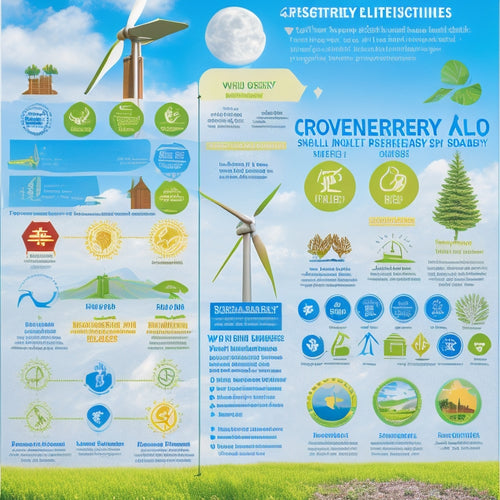
What Drives Optimal Solar Panel Performance Tracking?
Share
To optimize solar panel performance, you'll want to combine advanced data analytics, real-time monitoring, and automated fault detection. Integrate accurate weather forecasting and energy production forecasting models to guarantee maximum energy output and efficiency. By leveraging these tools, you'll be able to identify areas for improvement, pinpoint deviations from peak performance, and enable data-driven decision-making. As you explore these key drivers, you'll uncover the intricate details that maximize your solar panel's performance potential.
Key Takeaways
• Advanced data analytics and visualization uncover hidden patterns, enabling data-driven decision-making for optimal solar panel performance.
• Real-time performance monitoring identifies areas for improvement, ensuring maximum efficiency and instant feedback for energy optimization.
• Automated fault detection systems utilizing machine learning enable swift corrective action, preventing energy losses and ensuring peak performance.
• Integrating advanced weather forecasting tools with real-time data analysis refines climate modeling, enhancing energy harvesting and optimizing efficiency.
• Energy production forecasting models, calibrated with machine learning and statistical inference, predict performance complexities, identifying areas for improvement.
Data Analytics and Visualization
By harnessing advanced data analytics and visualization tools, you can reveal insightful patterns and trends in your solar panel performance data, empowering data-driven decision-making and optimized system operation.
This enables you to identify areas of improvement, optimize energy output, and reduce maintenance costs. Through data storytelling, you can create a narrative around your data, uncovering hidden insights that inform strategic decisions.
Visual insights, such as interactive dashboards and charts, provide a clear and concise view of your system's performance, allowing you to pinpoint inefficiencies and take corrective action.
Real-Time Performance Monitoring
With your data analytics and visualization tools in place, you're now positioned to take real-time performance monitoring to the next level, where every minute counts in optimizing your solar panel's energy output.
You can track your panel's performance in real-time, identifying areas of improvement to maximize panel efficiency. This instantaneous feedback enables you to pinpoint any deviations from peak performance, ensuring system reliability.
Automated Fault Detection Systems
How can you guarantee that even the slightest deviations from peak performance don't go unnoticed, enabling you to take swift corrective action to prevent energy losses? Automated fault detection systems are the answer.
By leveraging machine learning algorithms, these systems can identify anomalies in real-time, allowing you to take proactive measures to prevent energy losses. Predictive maintenance becomes a reality, as the system learns to recognize patterns and detect potential issues before they occur.
With automated fault detection, you can make certain that your solar panel performance remains at its best, and energy losses are minimized. This proactive approach enables you to take control of your solar panel's performance, ensuring maximum energy output and minimizing downtime.
Advanced Weather Forecasting Tools
As you implement advanced weather forecasting tools, you'll need to leverage accurate climate modeling to better understand the environmental factors affecting your solar panel performance.
This involves integrating real-time data analysis to refine your predictions and optimize energy output.
Accurate Climate Modeling
As you aim for peak solar panel performance, you understand the significance of accurate climate modeling.
Advanced weather forecasting tools, such as large-eddy simulation models and ensemble forecasting systems, enable precise climate modeling by providing high-resolution simulations of atmospheric conditions. These tools help you grasp climate variability, allowing you to better comprehend the intricacies of atmospheric parameters.
By leveraging these advanced tools, you can refine your understanding of local climate conditions, which is essential for maximizing solar panel efficiency. With accurate climate modeling, you can pinpoint ideal panel angles, orientations, and installation locations, ultimately leading to enhanced energy harvesting.
Real-time Data Analysis
You can leverage advanced weather forecasting tools to analyze real-time data, refining your understanding of local climate conditions and allowing you to make data-driven decisions that optimize solar panel performance.
By integrating machine learning algorithms, you can identify patterns and anomalies in weather data, ensuring accurate predictions and proactive maintenance.
Effective data governance is pivotal in this process, as it guarantees data quality, security, and compliance.
With real-time data analysis, you can pinpoint areas of improvement, optimize panel tilt and orientation, and schedule maintenance during periods of low energy production.
Energy Production Forecasting Models
When developing energy production forecasting models, you'll need to take into account the importance of model calibration techniques, as they directly impact the accuracy of your predictions.
You'll also want to examine the quality of your data, as any discrepancies can greatly impact your forecasting results.
Model Calibration Techniques
Accurate energy production forecasting relies on model calibration techniques that fine-tune energy production forecasting models to minimize the discrepancy between predicted and actual solar panel performance.
You'll want to leverage machine learning algorithms and statistical inference methods to refine your models. This involves adjusting parameters to guarantee that your forecasting models accurately capture the complexities of solar panel performance.
By calibrating your models, you can reduce the margin of error and make more informed decisions about solar panel maintenance and optimization.
Effective model calibration techniques enable you to identify areas for improvement, optimize energy production, and maximize your return on investment.
Data Quality Impact
By refining energy production forecasting models through calibration, it's equally important to acknowledge that even the most sophisticated models can be severely hindered by poor data quality. You need to guarantee that your data is accurate, complete, and reliable.
This is where data governance comes into play. Effective data governance ensures that your data is reliable and consistent, which is essential for peak solar panel performance tracking.
Moreover, sensor calibration is vital to ensure that your sensors are providing accurate readings. If your sensors aren't calibrated correctly, your data will be flawed, leading to inaccurate forecasts.
Weather Pattern Analysis
Analyzing weather patterns is essential for developing energy production forecasting models that can accurately predict solar panel performance. Factors such as temperature, cloud cover, and atmospheric pressure need to be taken into account to generate reliable forecasts.
You'll want to examine cloud formation patterns as they greatly impact solar irradiance. Atmospheric pressure also plays a vital role; changes in pressure can affect temperature and humidity, ultimately influencing energy output.
By incorporating these factors into your forecasting model, you'll be able to make more precise predictions about energy production. This, in turn, will enable you to maximize solar panel performance and optimize energy yield.
Customizable Reporting and Alerts
You can configure custom reports to provide concise, actionable insights into your solar panel performance, tailored to your specific needs and preferences. This allows you to focus on the metrics that matter most to you, without being overwhelmed by unnecessary data. With customizable reporting, you can set alert thresholds to notify you of potential issues before they impact performance. This helps prevent alert fatigue, ensuring you're only notified when it's vital.
| Alert Type | Threshold | Notification Method |
|---|---|---|
| Low Energy Output | < 80% of expected | Email and SMS |
| High Temperature | > 80°C | SMS only |
| Inverter Fault | Any fault code | Email and Phone call |
| Low Insolation | < 500 W/m² | Email only |
| Grid Connection Loss | Any disconnection | SMS and Phone call |
Integration With Existing Systems
Your solar panel performance tracking system seamlessly integrates with existing systems, allowing you to leverage the data and insights gathered to optimize energy production and reduce downtime. This integration enables you to make data-driven decisions, streamline operations, and improve overall efficiency.
With system compatibility and data interoperability, you can:
- Consolidate data from various sources into a single platform
- Automate workflows and reduce manual interventions
- Enhance real-time monitoring and predictive analytics
- Improve collaboration across teams and stakeholders
- Guarantee compliance with industry standards and regulations.
Frequently Asked Questions
Can Solar Panels Work Efficiently in Cold Climates?
You'll find that solar panels can still work efficiently in cold climates, as lower temperatures actually increase their energy output, but winter performance may be affected by snow cover and shorter days.
How Often Should I Clean My Solar Panels?
'You'll want to clean your solar panels regularly to minimize dust accumulation, which can reduce energy output. Establish a maintenance schedule to guarantee peak performance, as dirty panels can lead to significant energy losses over time.'
Can I Install Solar Panels on My Old Roof?
You should conduct a thorough Roof Inspection to confirm that your old roof's Structural Integrity can support the added weight of solar panels, verifying it can withstand various environmental conditions and loads before installation.
Do Solar Panels Generate Power During a Power Outage?
During a power outage, you won't generate power with standard grid-tied solar panels, but with a grid backup system and energy storage, you can harness solar energy even when the grid is down.
Are Solar Panels Environmentally Friendly?
You're wondering if solar panels are environmentally friendly? Yes, they are! By harnessing renewable energy, you reduce your carbon footprint, leveraging green technology to minimize environmental impact, and promote a sustainable future.
Related Posts
-

Solar Power Systems for Cost-Effective Sustainability
Investing in solar power systems is a smart move for cost-effective sustainability. You can save about $1,500 annuall...
-

Integrating Solar Panels Into Home Design
Integrating solar panels into your home design greatly enhances energy efficiency and lowers utility bills while addi...
-

Renewable Energy Certifications for Businesses
Renewable energy certifications are essential for your business, showcasing your commitment to sustainability and enh...


